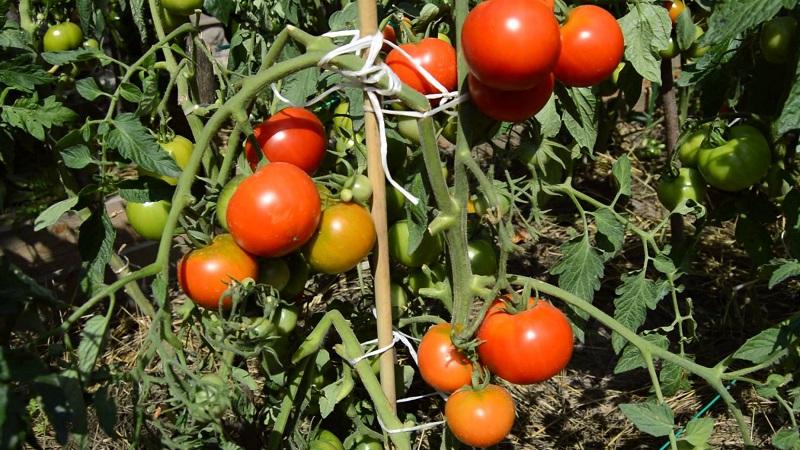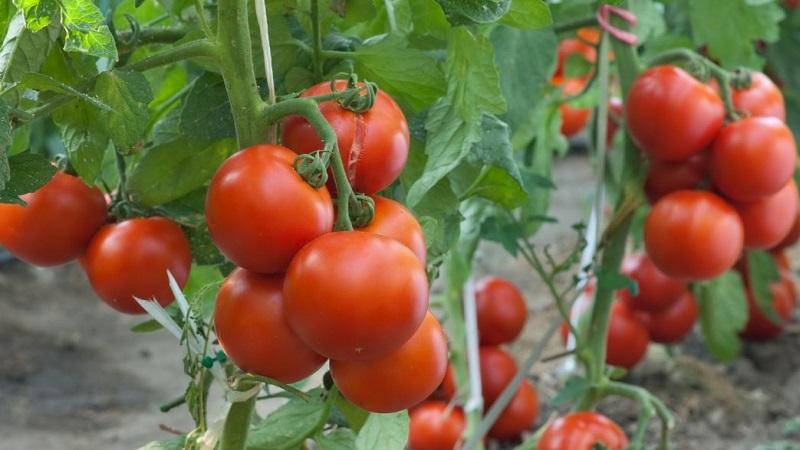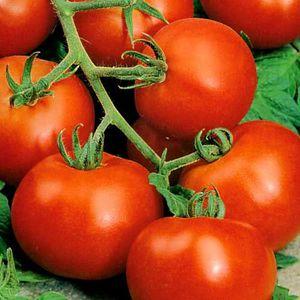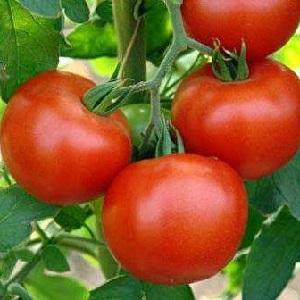Why is everyone so fond of the Dachnik tomato?
Many summer residents consider this variety of tomatoes ideal for growing both in open ground and in an apartment. It is resistant to pests and does not need special attention. The variety is called: Summer resident.
In addition to the listed advantages, it does not take up much space in the garden when growing and gives fruit for a long time. In addition, many people also love it for the possibility of cultivating it on an industrial scale. The plant is distinguished by its unpretentious care and good harvest safety.
The content of the article
Description, characteristics and indicators of productivity
The fruits collected from one bush have the same, 100% presentation.
Characteristics and description of the tomato variety:
- Variety - determinant.
- Disease resistance is average.
- The bush is small in size, grows up to 50 cm.The stems take up little space, which is convenient for small areas, greenhouses or loggias. There is little green mass on the branches, which makes it possible to get more sunlight and accelerates the process of fruit ripening.
- The culture is grown both at home and outdoors.
- The inflorescences of the Summer Resident have a complex appearance. During fruiting, 4-5 fruits are formed on each cluster.
- The variety does not mature for long. The growing season, depending on the region, is 95-110 days. The crop thrives outdoors even in cool weather. The variety manages to bear fruit before the onset of phytophthora.
- The best predecessors of the Summer Resident are onions, carrots, cabbage, legumes. After pepper and potatoes, it is undesirable to grow a vegetable, since the risk of its disease increases significantly late blight.
- The weight of tomatoes ranges from 50 to 150 g. The fruits are round and bright scarlet in color.
- The tomatoes taste pleasant with a slight sourness.
- For early maturing varieties, the yield is decent. From 1 sq. m turns out about 4 kg, on an industrial scale - up to 360 c / ha. The bushes are always covered with tomatoes. The plant gives off all its fruits until the beginning of autumn.
On a note. 100 g of product contains: 3.3% of total sugar, 5.6% of dry matter in juice, 17.2 mg of ascorbic acid.
Description of the characteristics of tomatoes The summer resident says that the variety is cold-resistant and versatile for growing. For many, these parameters are a priority, so it's worth taking a closer look at the variety.

Disadvantages and advantages
Dachnik tomatoes have more advantages than disadvantages. Gardeners like it for the following reasons:
- the bushes have a convenient compact shape;
- yield does not decrease even in poorly lit areas;
- productivity does not depend on weather conditions;
- a tomato grows even on the windowsill;
- fruits ripen early;
- the culture is resistant to disease;
- bushes do not need garter and shaping;
- the variety bears fruit for a long time.
Disadvantages: fruits are small in size and sour taste. There were no more visible flaws in the variety.
How to grow
The summer resident is easy to grow and care for. In the southern regions, seeds are sown directly into the ground in May. In mid-latitudes, tomatoes are sown in May in unheated greenhouses, but when the weather without frost sets in June, the bushes are transplanted into an open priming.
For 1 sq. m of open ground planted up to 6 tomato bushes. The great advantage of the variety is that it does not require a garter, formation and removal of stepsons. Water the plant abundantly immediately after planting and mulch 5-10 cm with a layer of straw. This will reduce further watering, which is especially convenient when there is a lack of water or if you are not often in the country.
If the bushes fall on the ground under the weight of the fruit, they can all ripen quietly on a straw bed. Moreover, they will not be susceptible to various diseases.

Care features
Plant care is performed as follows:
- Seedlings watered in moderation, without flooding, so that mold does not grow on the ground. Otherwise, the black leg will destroy the plant. After the appearance of the second leaf, a pick is carried out. At the same time, the main root is pinched at the end, then the bush will be strong and strong.
- The ground near the stem must be loosened, since it becomes crusty from watering. Tomatoes are watered with settled warm water under the plant, in the morning or evening, but not at noon, when it is hot. When it is very stuffy, the seedlings should be sprayed at the same time.
- Top dressing is carried out as soon as the first ovaries are formed, using diluted manure with clean water in a ratio of 0.5 liters of manure to 10 liters of water. Another 1 tsp is mixed. superphosphate and 1 tsp. potassium sulfate. Top dressing is carried out three weeks after the tomatoes are planted.
- Tomatoes will pick up color faster if the fruits are removed after brown spots appear on them. Indoors, vegetables will ripen quickly. Heavy branches of the bushes are tied up to avoid kinks.
- In mid-August, the plants need to be pinched at the top of the stem and all inflorescences removed. This will speed up the ripening time of fruits that have already set.
- If tomatoes lack nitrogen (leaves turn purple and small), plant 4-5 stem pea bushes around the plant. After 1-2 weeks, the bushes will come to life.
For your information. If the tomatoes are planted correctly and properly looked after, the Summer resident will begin to bear fruit before pests and diseases from other crops spread throughout the garden.
Harvesting and storage
The summer resident is distinguished by good preservation of the fruits, but there is always an opportunity to extend the shelf life of tomatoes, and it is foolish not to use it. Harvested tomatoes last longer if kept at the appropriate temperature.
Important! The duration of the preservation of the quality and taste of vegetables depends on the competent preparation of the store and the observance of all the necessary conditions.
Experienced gardeners share the following tips:
 store the harvest of tomatoes in a clean, dried and disinfected room (cellar, basement or refrigerator);
store the harvest of tomatoes in a clean, dried and disinfected room (cellar, basement or refrigerator);- the most suitable temperature for storage is + 10 ... + 12 ° С;
- optimal humidity - 80-85%;
- no light is needed for long-term storage of tomatoes;
- Tomatoes last better and longer if harvested unripe.
During storage, the fruit "breathes", releasing moisture, and micro-processes (mold and decay) can develop in them. To avoid this, vegetables are stored in wooden or plastic boxes, tails up.
Prevention of diseases and pests
Summer resident tomatoes are famous for the fact that the variety is practically not affected by pests and diseases. However, in order to be 100% sure of the quality of the future harvest, experienced gardeners recommend using preventive measures.
As a rule, the fight against tomato diseases begins at the seedling stage. Prevent culture diseases in the following ways:
- An effective remedy for the prevention of tomato diseases - Bordeaux liquid 0.5%. After planting, the seedlings are treated with an interval of 14 days with an increase in the percentage of solution to 1. A similar procedure is carried out until the fruits begin to turn brown.
- The method of processing with copper sulfate is equally popular. But you should not prepare a concentrated solution, since the active ingredient is very toxic. Copper oxychloride (40 g per 10 liters of water) is also excellent as a prophylactic agent.
- Calcium nitrate - a good drug to protect against common diseases. The substance is excellent in particular for combating top rot (10 g of nitrate per 10 liters of water). The solution is sprayed on the plants and applied at the root every week.
Popular methods of pest prevention are no less popular. These safe products are excellent substitutes for chemicals.
To prevent late blight disease, three recipes are used:
- In 6 liters of hot water, 1 g of potassium permanganate and 1 cup of crushed garlic are diluted. The prepared mixture is sprayed two weeks after the tomatoes are planted. Further spraying is carried out at intervals of 10 days. Garlic porridge includes the heads, leaves and stalks of garlic. The garlic gruel can be doubled, the amount of potassium permanganate can be left the same.
- One of the simplest preventive measures is kefir treatment. To prepare the solution, you will need to pour 1 liter of kefir into 10 liters of water. Tomatoes are sprayed 2 weeks after transplanting.
- Wood ash processing. For this procedure, you will need to sift the ash through a sieve, then sprinkle it on the foliage of the plants. Processing is carried out every 5 days. This method prevents tomato diseases and increases the yield.
On a note. The ground in the tomato garden should not be bare, otherwise it will be difficult for them to protect themselves from diseases and pests. Plant adjacent plants such as parsley, dill, and onions at the "feet" of the tomatoes. The plant underneath will always be moisturized and shaded.
Reviews of gardeners
Despite the positive qualities of tomatoes Summer resident, reviews of summer residents about the yield vary.
 Ekaterina, Perm: “I have been planting summer resident tomatoes in the open field for several years. Summer weather was changeable. But I trust this variety, and it has never let me down. I use Dachnik tomatoes for conservation, and for eating fresh I prefer other varieties, but I have to dance around them. And this tomato is easy to grow. He is unpretentious in care and practically does not get sick. The harvest suits me. From each bush I collect about three kg of a quality crop. "
Ekaterina, Perm: “I have been planting summer resident tomatoes in the open field for several years. Summer weather was changeable. But I trust this variety, and it has never let me down. I use Dachnik tomatoes for conservation, and for eating fresh I prefer other varieties, but I have to dance around them. And this tomato is easy to grow. He is unpretentious in care and practically does not get sick. The harvest suits me. From each bush I collect about three kg of a quality crop. "
Natalia, Arkhangelsk: “I liked the variety very much! I recommend it to everyone who has not been able to grow tomatoes. This variety is easy to grow, and the fruits grow the same as in the photo of the package with seeds. After I plant the seedlings, water the plant abundantly, and then cover it with a 5-10 cm layer of straw, I hardly pay attention to it. Not my stepson, I don't tie up. If the summer is good, the Summer resident gives a decent harvest, which he himself simply falls on the straw. Not everyone will like the taste of tomatoes, but for this there are raspberry, yellow varieties that are grown only in a greenhouse. And if there is no such structure, then the Summer Resident will save you. "
Veronica, Tomsk: “I knew that the Summer resident was intended for growing in the open field, and yet I tried to plant a few bushes in the greenhouse. When planting seedlings, I did everything in the same way as when planting plants in open ground. I hoped that they would ripen the very first, and they began to bear fruit along with mid-season varieties. The fruit weighed about 150 grams, and there were a lot of them. I prepare juice and tomato paste from them. "
Conclusion
Tomato Summer resident is well suited both for open ground and for growing in a greenhouse or even on a windowsill in an apartment. This versatile variety requires a minimum of maintenance and yields good yields even in cold summers.
Due to the compactness of the bush, it can be grown in a small summer cottage, while having a sufficient amount of harvest. The fruits are suitable for preserving and making excellent juice. Even inexperienced vegetable growers can cope with the cultivation of a wonderful variety.
All the most interesting about the tomato Summer resident is further in the video: